This page was generated from docs/devices/quick-xylo/xylo-audio-intro.ipynb.
Interactive online version:
🐝🎵 Introduction to Xylo™Audio
Xylo™Audio is a platform for audio sensory processing, combining a low-power analog audio front-end with a low-power SNN inference core. Xylo™Audio is designed for sub-mW audio processing, in always-on applications.
This notebook gives you an overview of interfacing from Rockpool to the various cores of Xylo™Audio.
See also 🐝⚡️ Quick-start with Xylo™ SNN core and Using the analog frontend model.
Note: In this tutorial Xylo™Audio refers to Xylo™Audio 2 and Xylo™Audio 3. In case differences occur we will explicitly name the correct HDK.
[1]:
# Specify the xylo board you would like to use for this tutorial
# Available boards: XyloAudio2 and XyloAudio3
xylo_board_name = 'XyloAudio3'
[2]:
# - Display images
from IPython.display import Image
Image('xylo-a2-block-level.png')
[2]:
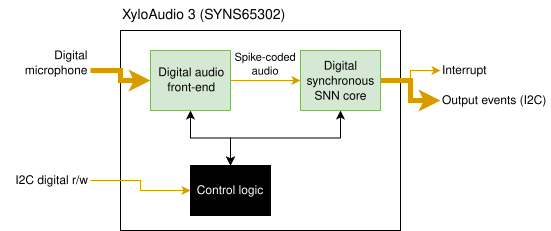
[3]:
# - Display images
from IPython.display import Image
Image('xylo-a3-block-level.png')
[3]:
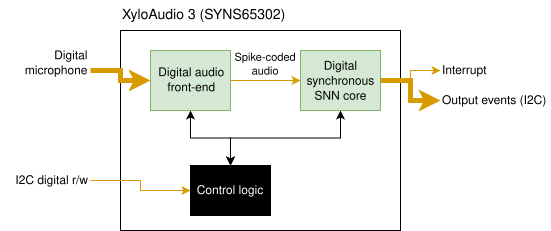
Part I: Using the XyloAudio SNN Core
Interfacing with the XyloAudio SNN core is the same as for other Xylo family devices, making use of the Xylo deployment pipeline;
syns61201.XyloSim and syns61201.XyloSamna, for XyloAudio 2;
and syns65302.XyloSim and syns65302.XyloSamna, for XyloAudio 3.
See also 🐝⚡️ Quick-start with Xylo™ SNN core and 🐝 Overview of the Xylo™ family.
[4]:
Image('XyloSamna.png', width=400)
[4]:
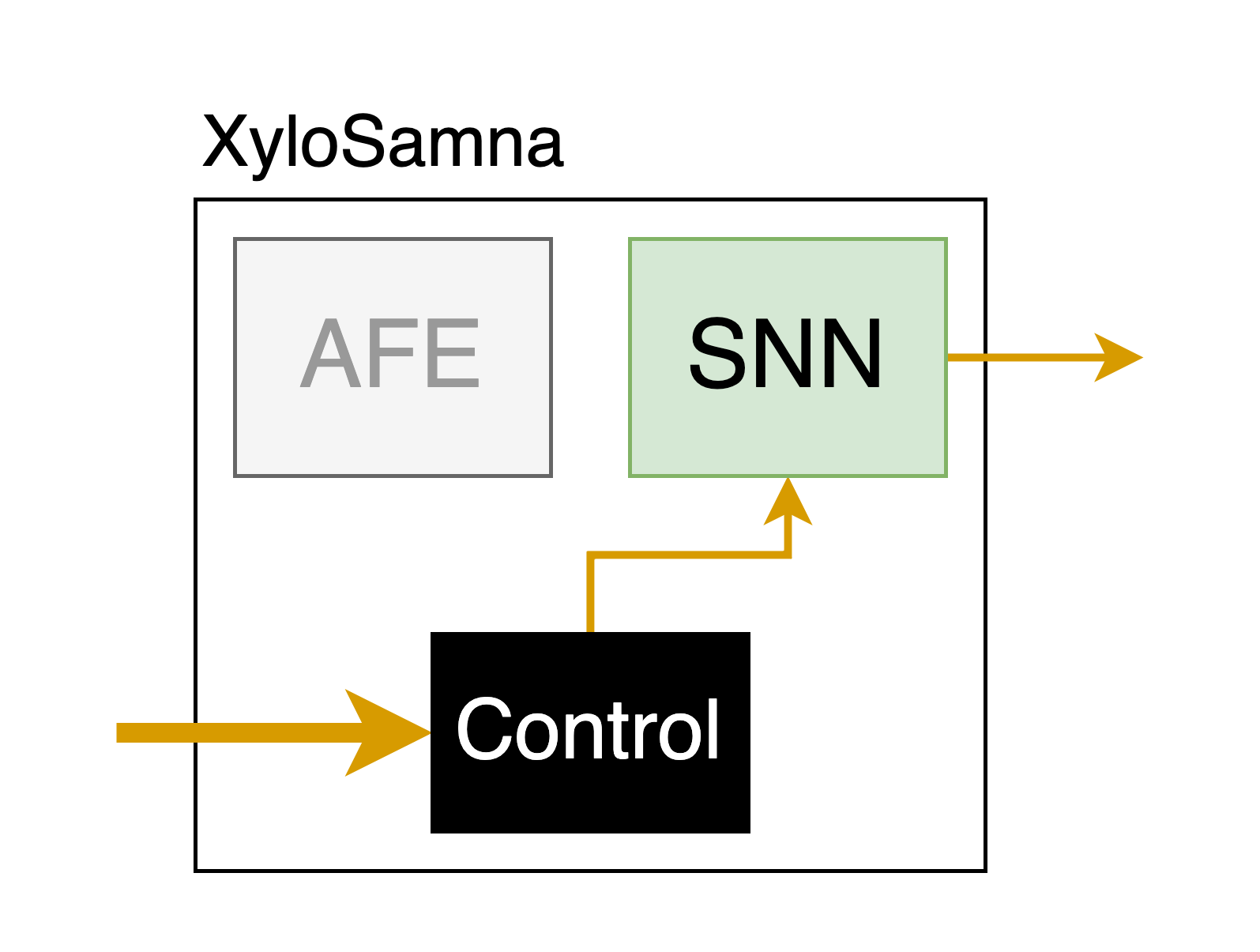
Step 1: Build a network in rockpool and convert it to a hardware configuration
[5]:
# - Import the computational modules and combinators required for the network
from rockpool.nn.modules import LIFTorch, LinearTorch
from rockpool.nn.combinators import Sequential, Residual
from rockpool.transform import quantize_methods as q
from rockpool import TSEvent, TSContinuous
# - Imports dependent on your HDK
# - XyloAudio 2
if xylo_board_name == 'XyloAudio2':
import rockpool.devices.xylo.syns61201 as xa2
from rockpool.devices.xylo.syns61201 import xa2_devkit_utils as xa2utils
# - XyloAudio 3
elif xylo_board_name == 'XyloAudio3':
import rockpool.devices.xylo.syns65302 as xa3
from rockpool.devices.xylo.syns65302 import xa3_devkit_utils as xa3utils
import numpy as np
try:
from rich import print
except:
pass
import sys
!{sys.executable} -m pip install --quiet matplotlib
import matplotlib.pyplot as plt
%matplotlib inline
plt.rcParams['figure.figsize'] = [12, 4]
plt.rcParams['figure.dpi'] = 300
# - Disable warnings
import warnings
warnings.filterwarnings('ignore')
from IPython import display
[6]:
# - Define the size of the network layers
Nin = 2
Nhidden = 4
Nout = 2
dt = 1e-3
[7]:
# - Define the network architecture using combinators and modules
net = Sequential(
LinearTorch((Nin, Nhidden), has_bias = False),
LIFTorch(Nhidden, dt = dt),
Residual(
LinearTorch((Nhidden, Nhidden), has_bias = False),
LIFTorch(Nhidden, has_rec = True, threshold = 1., dt = dt),
),
LinearTorch((Nhidden, Nout), has_bias = False),
LIFTorch(Nout, dt = dt),
)
print(net)
# - Scale down recurrent weights for stability
# net[2][1].w_rec.data = net[2][1].w_rec / 10.
TorchSequential with shape (2, 2) { LinearTorch '0_LinearTorch' with shape (2, 4) LIFTorch '1_LIFTorch' with shape (4, 4) TorchResidual '2_TorchResidual' with shape (4, 4) { LinearTorch '0_LinearTorch' with shape (4, 4) LIFTorch '1_LIFTorch' with shape (4, 4) } LinearTorch '3_LinearTorch' with shape (4, 2) LIFTorch '4_LIFTorch' with shape (2, 2) }
[8]:
# - Call the Xylo mapper on the extracted computational graph
# - For XyloAudio 2
if xylo_board_name == 'XyloAudio2':
spec = xa2.mapper(net.as_graph(), weight_dtype='float', threshold_dtype='float', dash_dtype='float')
# - For XyloAudio 3
elif xylo_board_name == 'XyloAudio3':
spec = xa3.mapper(net.as_graph(), weight_dtype='float', threshold_dtype='float', dash_dtype='float')
# - Quantize the specification
spec.update(q.global_quantize(**spec))
# # you can also try channel-wise quantization
# spec.update(q.channel_quantize(**spec))
# print(spec)
# - Use rockpool.devices.xylo.config_from_specification to convert it to a hardware configuration
# - For XyloAudio 2
if xylo_board_name == 'XyloAudio2':
config, is_valid, msg = xa2.config_from_specification(**spec)
# - For XyloAudio 3
elif xylo_board_name == 'XyloAudio3':
config, is_valid, msg = xa3.config_from_specification(**spec)
if not is_valid:
print(msg)
[9]:
# - Use rockpool.devices.xylo.find_xylo_hdks to connect to an HDK
from rockpool.devices.xylo import find_xylo_hdks
xylo_hdk_nodes, modules, versions = find_xylo_hdks()
print(versions)
hdk = None
for version, xylo in zip(versions, xylo_hdk_nodes):
if version == "syns61201":
hdk = xylo
# - For XyloAudio 3
elif version == "syns65302":
hdk = xylo
if hdk is None:
assert False, 'This tutorial requires a connected XyloAudio HDK to demonstrate.'
The connected Xylo HDK contains a XyloAudio 3. Importing `rockpool.devices.xylo.syns65302`
['syns65302']
[10]:
print(xylo_board_name)
# - Use XyloSamna to deploy to the HDK
if hdk:
# - For XyloAudio 2
if xylo_board_name == 'XyloAudio2':
modSamna = xa2.XyloSamna(hdk, config, dt = dt)
# - For XyloAudio 3
elif xylo_board_name == 'XyloAudio3':
modSamna = xa3.XyloSamna(hdk, config, dt = dt)
print(modSamna)
XyloAudio3
XyloSamna with shape (2, 8, 2)
[11]:
# - Generate some Poisson input
T = 100
f = 0.4
input_spikes = np.random.rand(T, Nin) < f
TSEvent.from_raster(input_spikes, dt, name = 'Poisson input events').plot();
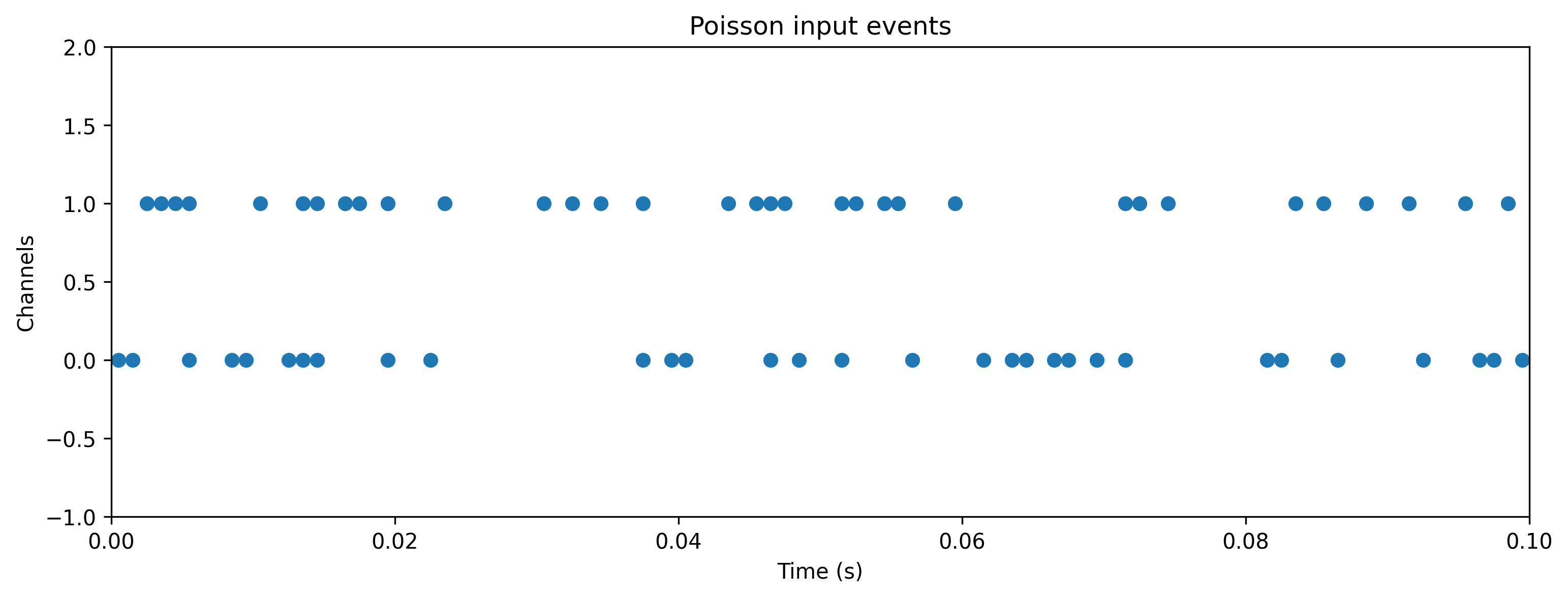
[12]:
# - Evolve the network on the Xylo HDK
# - `reset_state` is only needed for XyloAudio 2
if xylo_board_name == 'XyloAudio2':
modSamna.reset_state()
out, _, r_d = modSamna(input_spikes, record = True)
# - Show the internal state variables recorded
print(r_d.keys())
dict_keys(['Vmem', 'Isyn', 'Isyn2', 'Spikes', 'Vmem_out', 'Isyn_out', 'times', 'inf_duration'])
[13]:
# - Plot some internal state variables
plt.figure()
plt.imshow(r_d['Spikes'].T, aspect = 'auto', origin = 'lower')
plt.title('Hidden spikes')
plt.ylabel('Channel')
plt.figure()
TSContinuous(r_d['times'], r_d['Isyn'], name = 'Hidden synaptic currents').plot(stagger = 127)
plt.figure()
TSContinuous(r_d['times'], r_d['Vmem'], name = 'Hidden membrane potentials').plot(stagger = 127);
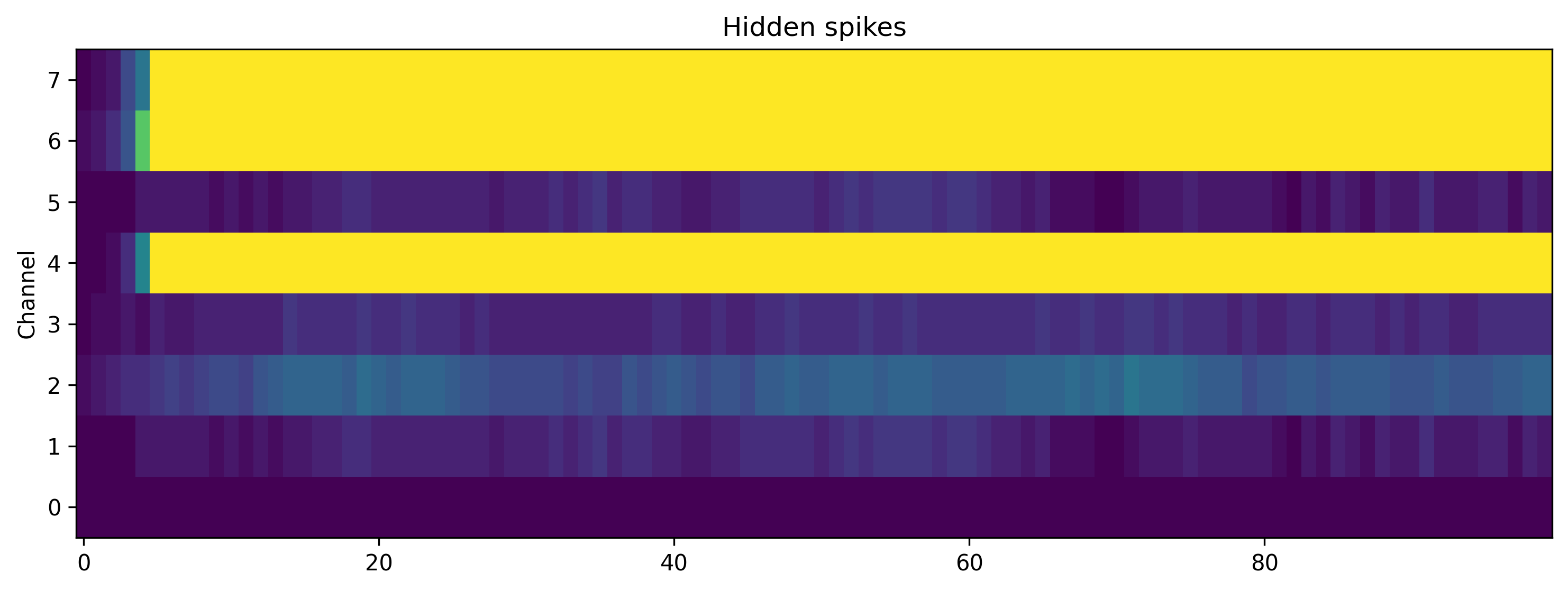
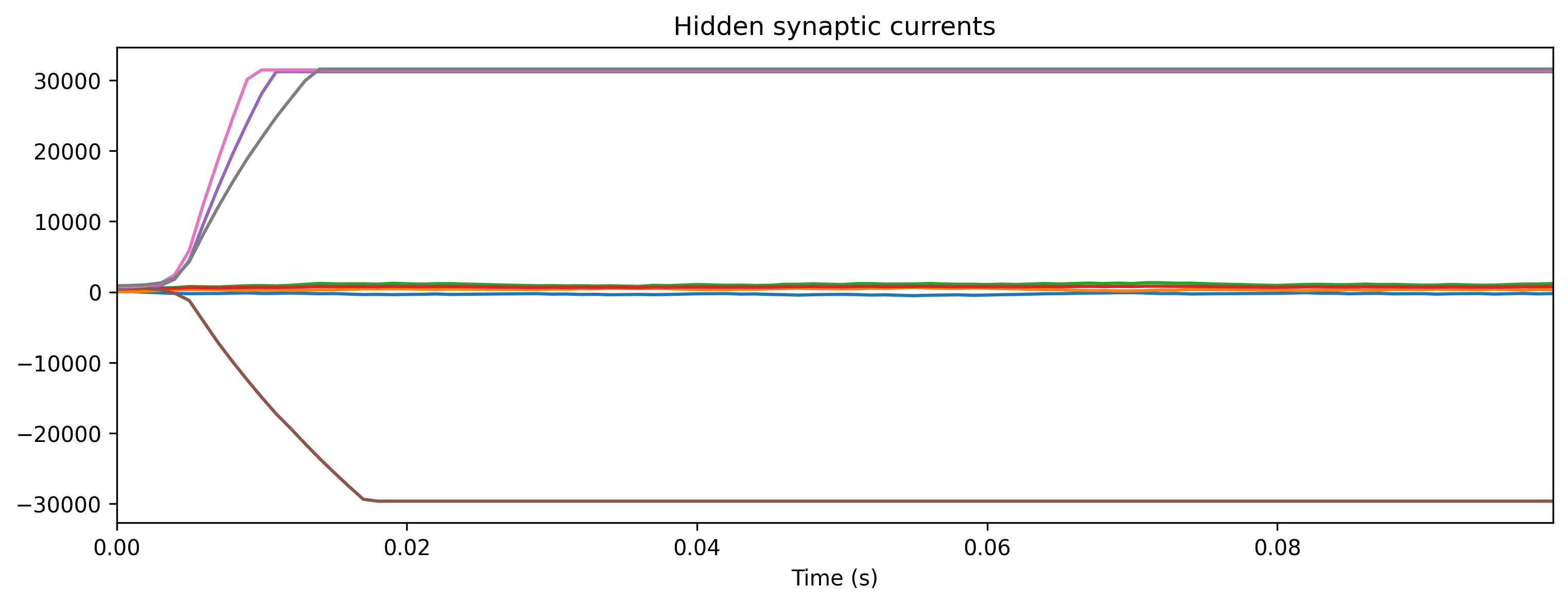
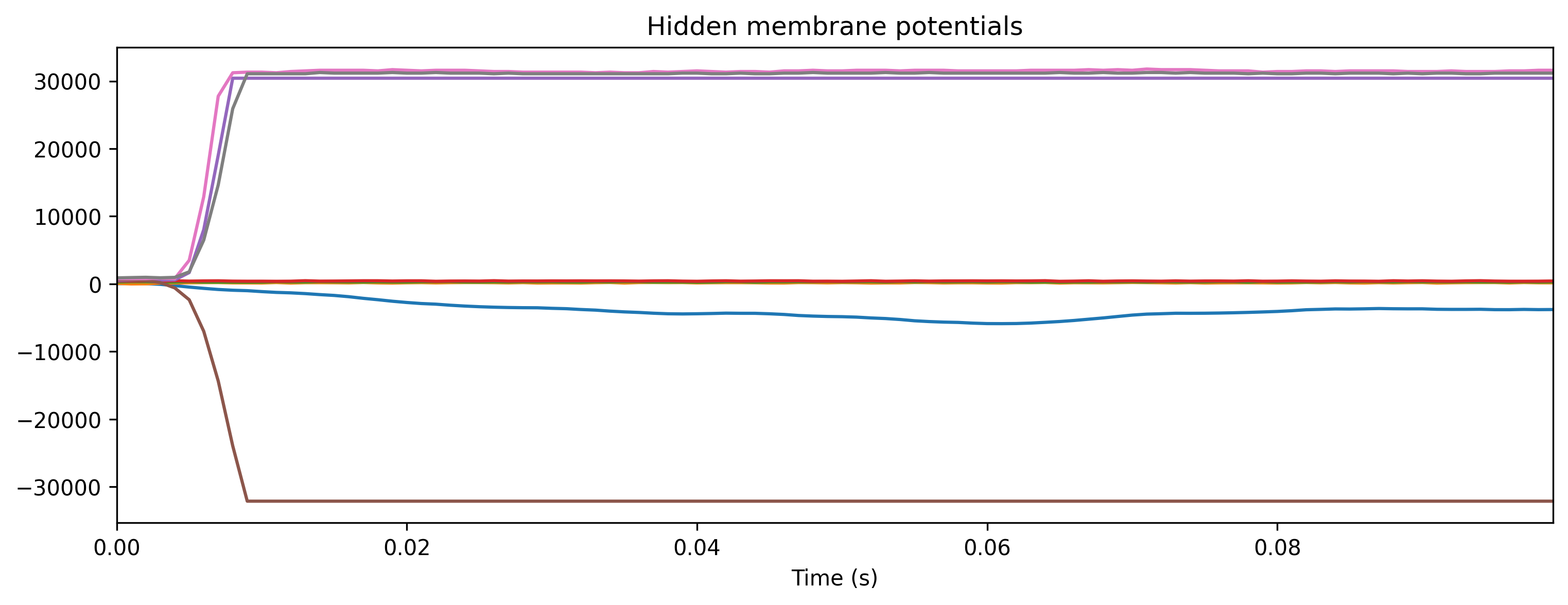
Step 3: Simulate the HDK using the XyloSim bit-precise simulator
[14]:
# - Configure the simulator with the HW network config
# - For XyloAudio 2
if xylo_board_name == 'XyloAudio2':
modSim = xa2.XyloSim.from_config(config, dt=dt)
# - For XyloAudio 3
elif xylo_board_name == 'XyloAudio3':
modSim = xa3.XyloSim.from_config(config, dt=dt)
print(modSim)
XyloSim with shape (2, 8, 2)
[15]:
# - Evolve the input over the network, in simulation
out, _, r_d = modSim(input_spikes, record = True)
# - Show the internal state variables recorded
del modSim
print(r_d.keys())
dict_keys(['Vmem', 'Isyn', 'Spikes', 'Vmem_out', 'Isyn_out'])
[16]:
# - Plot some internal state variables
plt.figure()
plt.imshow(r_d['Spikes'].T, aspect = 'auto', origin = 'lower')
plt.title('Hidden spikes')
plt.ylabel('Channel')
plt.figure()
TSContinuous.from_clocked(r_d['Isyn'], dt, name = 'Hidden synaptic currents').plot(stagger = 127);
plt.figure()
TSContinuous.from_clocked(r_d['Vmem'], dt, name = 'Hidden membrane potentials').plot(stagger = 127);
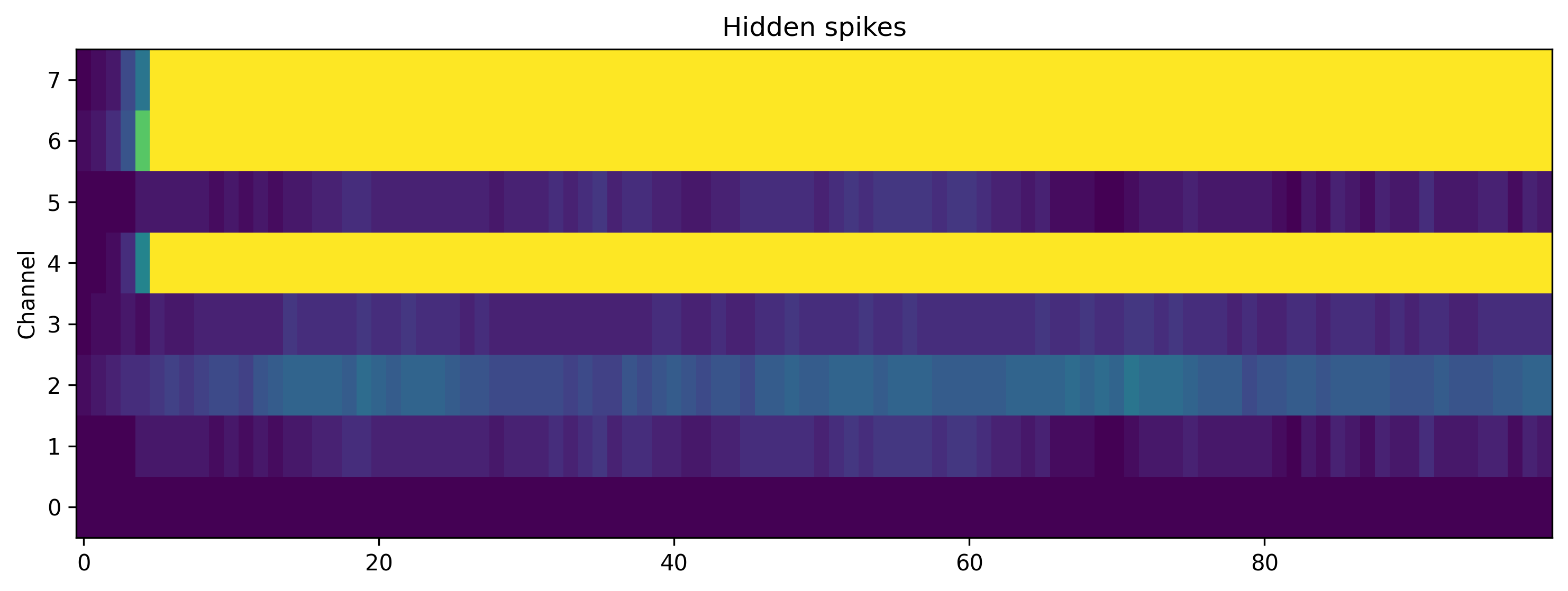
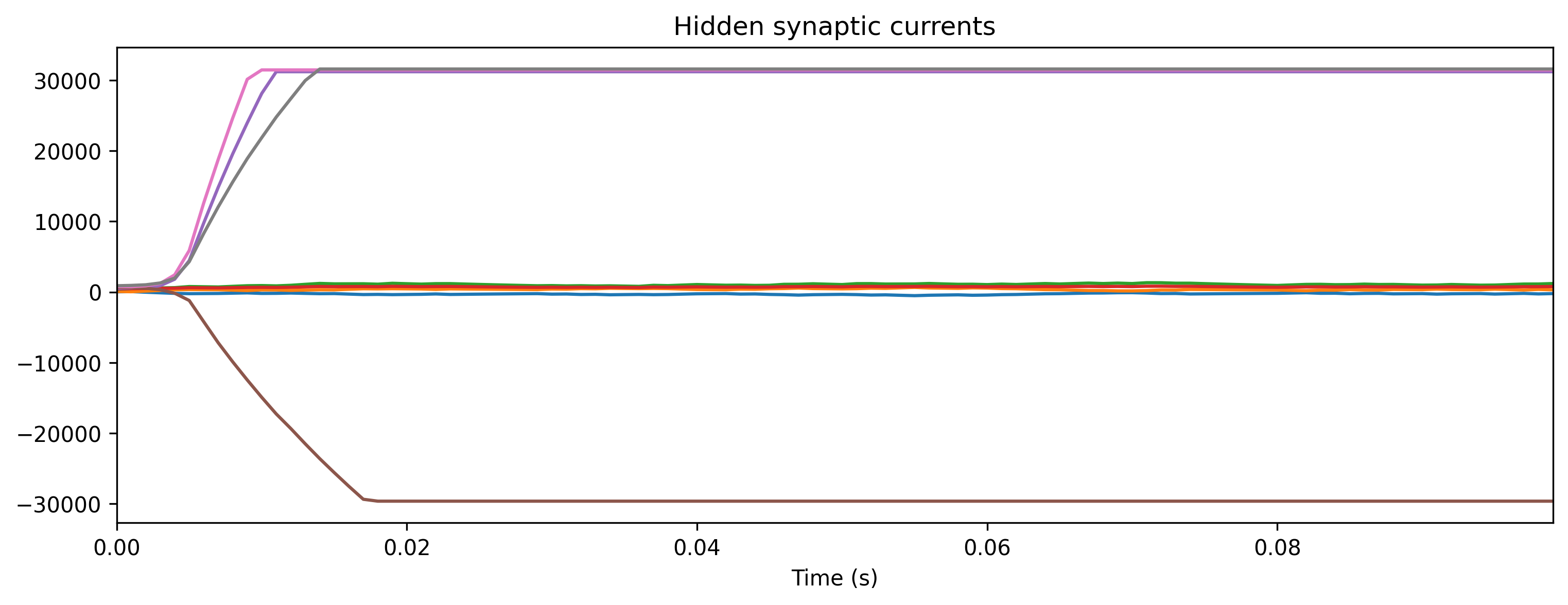
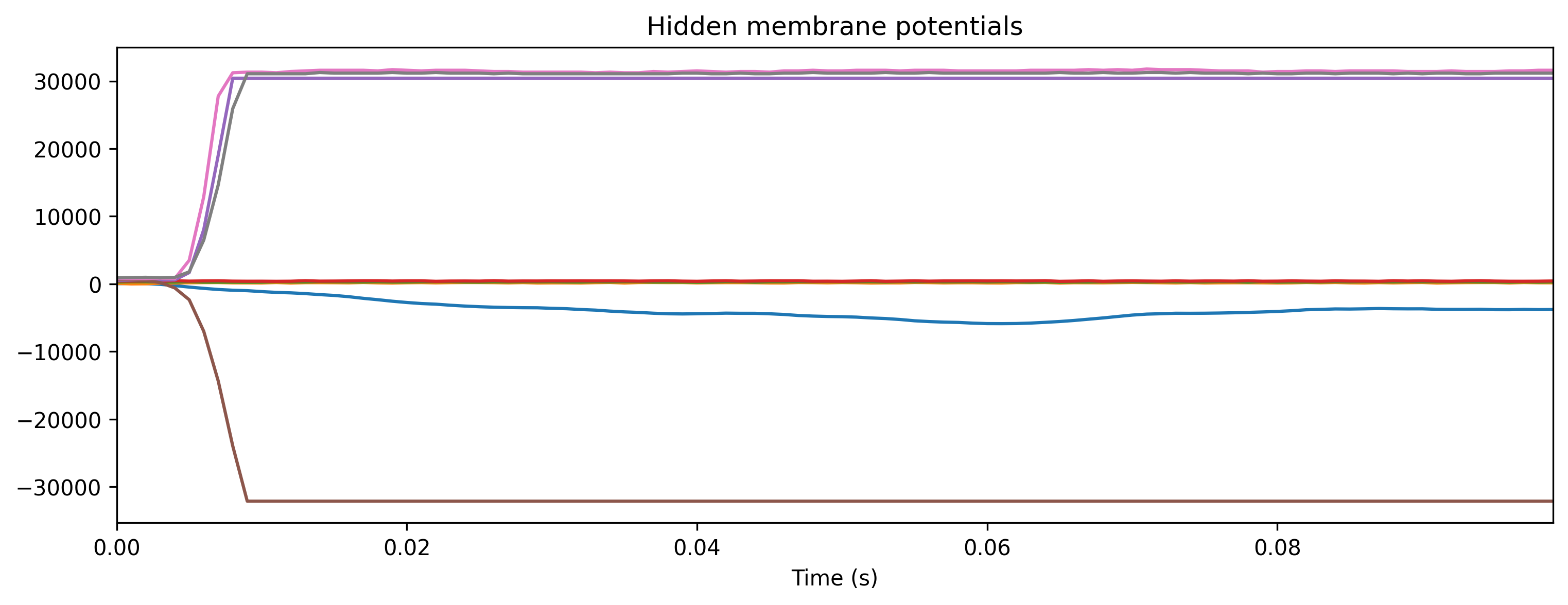
Part II: Using the XyloAudio audio front-end interface
Note: Audio front-end is only available in Xylo™Audio 2. This step does not applied to Xylo™Audio 3.
The AFE (Audio Front-End) is used to preprocess single-channel audio signals and convert them into spikes.
Here the audio signal is input to the AFE by a microphone mounted on the hardware dev kit, or an external differential analog audio signal.
The AFE has 16 output channels, and you can adjust its parameters via hyperparameters in the AFESamna class.
See also the introductory notebook Using the analog frontend model .
AFESamna allows you to access the audio front-end on the dev kit, and record encoded audio either from the on-board microphone or analog audio injected to the dev kit.
AFESamna also allows a custom config input which is without auto-calibration.
If you do not provide a custom config, we highly suggest you set auto_calibrate = True on instantiation, which helps to mitigate the effects of background and mechanical noise.
[17]:
Image('AFESamna.png', width=400)
[17]:

[18]:
# - Find and connect to a XyloAudio HDK
from rockpool.devices.xylo import find_xylo_hdks
xylo_hdk_nodes, modules, versions = find_xylo_hdks()
print(versions)
hdk = None
for version, xylo in zip(versions, xylo_hdk_nodes):
if version == "syns61201":
hdk = xylo
if version == "syns65302":
hdk = xylo
if hdk is None:
assert False, 'This tutorial requires a connected XyloAudio HDK to demonstrate.'
The connected Xylo HDK contains a XyloAudio 3. Importing `rockpool.devices.xylo.syns65302`
['syns65302']
[19]:
# - Set the time resolution and duration to record encoded audio
dt = 10e-3
timesteps = 1000
[20]:
# - Create an AFESamna module, which wraps the AFE on the Xylo A2 HDK
# (stay quiet while this cell is executing)
if xylo_board_name == 'XyloAudio2':
mod = xa2.AFESamna(hdk, None, dt=dt, auto_calibrate=True, amplify_level='low', hibernation_mode=False)
elif xylo_board_name == 'XyloAudio3':
mod = xa3.AFESamna(hdk, None, dt=dt, auto_calibrate=True, amplify_level='low', hibernation_mode=False)
print(mod)
AFESamna with shape (0, 1)
[21]:
# - Evolve the module to record encoded real-time audio as events
spikes_ts, _, _ = mod(np.zeros([0, timesteps, 0]))
del mod
[22]:
# - Plot some encoded audio events recorded from the AFE
plt.imshow(spikes_ts.T, aspect='auto', interpolation='none')
plt.title('#Spikes in AFE output channels')
plt.xlabel('Time')
plt.ylabel('Channel')
plt.show()
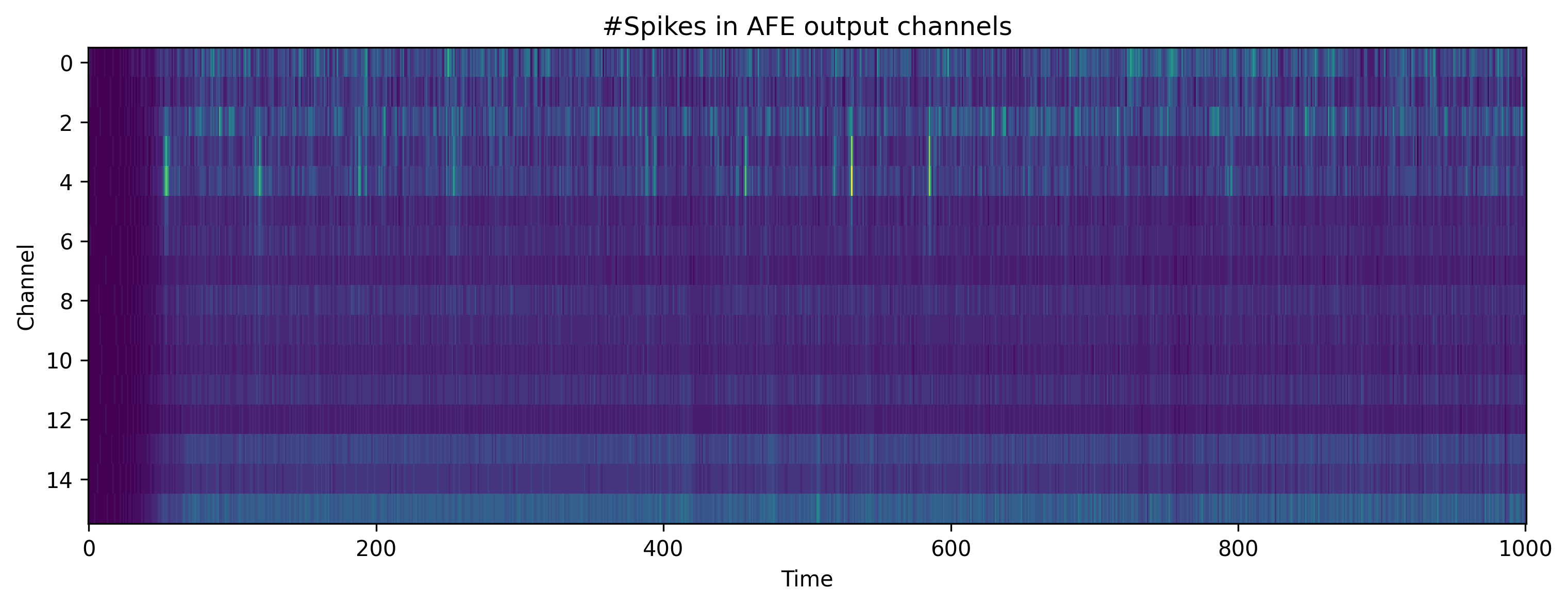
You can record encoded audio using the AFESamna class, and feed these outputs to the Xylo core for testing using XyloSamna.
You can also combine the two cores for inference, as shown in the following section.
Part III: Deploying the AFE and SNN cores in free-running inference mode
Once you have a complete chip HW specification, you can deploy it to the chip in real-time inference mode using the classes syns61201.XyloMonitor or syns65302.XyloMonitor for XyloAudio 2 and XyloAudio 3, respectively.
In XyloAudio 2, this mode uses the AFE core to preprocess audio signals in real-time and then sends encoded audio to the SNN core for inference.
In XyloAudio 3, this mode uses the digital microphone audio signal in real-time and then sends encoded audio to the SNN core for inference.
In this mode you only read the output events from the SNN core, without providing input.
[23]:
Image('XyloMonitor.png', width=400)
[23]:
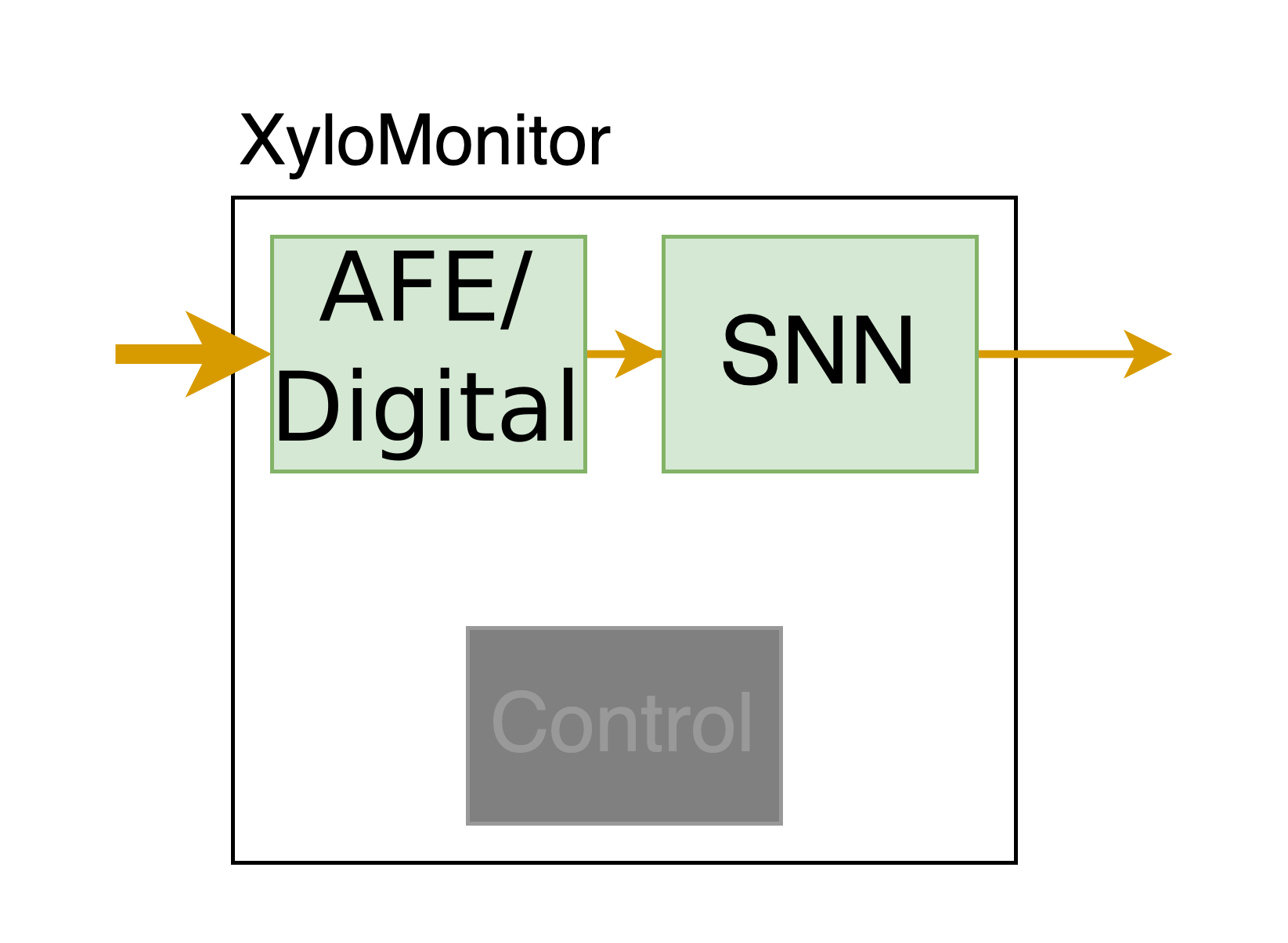
[24]:
# - Find and connect to a XyloAudio HDK
xylo_hdk_nodes, modules, versions = find_xylo_hdks()
print(xylo_hdk_nodes)
hdk = None
for version, xylo in zip(versions, xylo_hdk_nodes):
if version == "syns61201":
hdk = xylo
# - For XyloAudio 3
if version == "syns65302":
hdk = xylo
if hdk is None:
assert False, 'This tutorial requires a connected XyloAudio HDK to demonstrate.'
The connected Xylo HDK contains a XyloAudio 3. Importing `rockpool.devices.xylo.syns65302`
[<samna.xyloAudio3.XyloAudio3TestBoard object at 0x7685b9b29a30>]
[25]:
# - Use XyloMonitor to deploy to the HDK
output_mode = "Vmem"
amplify_level = "low"
hibernation = False
DN = True
T = 100
# - For XyloAudio 2
# - For XyloAudio 2 you need to wait 45s until the AFE auto-calibration is done
if xylo_board_name == 'XyloAudio2':
modMonitor = xa2.XyloMonitor(hdk, config, dt=dt, output_mode=output_mode, amplify_level=amplify_level, hibernation_mode=hibernation, divisive_norm=DN)
# - For XyloAudio 3
# - XyloAudio 3 does not have the amplify_level parameter and does not do AFE auto-calibration
elif xylo_board_name == 'XyloAudio3':
modMonitor = xa3.XyloMonitor(hdk, config, dt = dt, output_mode=output_mode, hibernation_mode=hibernation, dn_active=DN)
# - Perform inference on the Xylo board
# - The following line will evolve XyloMonitor for T time steps.
# - Keep in mind that this mode is using the microphone as input, hence the output might change according to the ambience noise
output, _, _ = modMonitor(input_data=np.zeros((T, Nin)))
Part IV: Measuring power on the XyloAudio HDK
syns61201.XyloSamna and syns65302.XyloSamna (respectively for XyloAudio 2 and XyloAudio 3) provide an interface to real-time power measurements on the XyloAudio HDK.
Current on several power nets on the chip can be sampled asynchronously, while the device is in operation.
The evolve() method provides a power measurement interface while the device is in inference mode, and the XyloSamna module can be used also to measure idle power.
[26]:
# - Find and connect to a XyloAudio HDK
xylo_hdk_nodes, modules, versions = find_xylo_hdks()
print(xylo_hdk_nodes)
hdk = None
for version, xylo in zip(versions, xylo_hdk_nodes):
if version == "syns61201":
hdk = xylo
# - For XyloAudio 3
elif version == "syns65302":
hdk = xylo
if hdk is None:
assert False, 'This tutorial requires a connected XyloAudio HDK to demonstrate.'
The connected Xylo HDK contains a XyloAudio 3. Importing `rockpool.devices.xylo.syns65302`
[<samna.xyloAudio3.XyloAudio3TestBoard object at 0x7685b9b29a30>]
On instantiation, XyloSamna can specify a power sampling frequency.
By default, power is measured at 5 Hz.
[27]:
# - For XyloAudio 2
if xylo_board_name == 'XyloAudio2':
# - Set a low clock frequency for the XyloAudio 2 device
xa2utils.set_xylo_core_clock_freq(hdk, 6.25)
# - Use XyloSamna to deploy to the HDK
modSamna = xa2.XyloSamna(hdk, config, dt = 10e-3, power_frequency=20.)
# - For XyloAudio 3
elif xylo_board_name == 'XyloAudio3':
import samna
# - Set a low clock frequency for the XyloAudio 3 device
xa3utils.set_xylo_core_clock_freq(hdk, 6.25)
# - Use XyloSamna to deploy to the HDK
modSamna = xa3.XyloSamna(hdk, config, dt = 10e-3, power_frequency=20.)
print(modSamna)
WARNING:samna.xyloAudio3:Requested PDM clock frequency 195312 could not be achieved, used 194552.52918287937 instead
WARNING:samna.graph:Graph is destroyed while running! Note: Filter nodes constructed by `sequential` method won't work after corresponding graph is destroyed and please manually stop the graph after use.
XyloSamna with shape (2, 8, 2)
[28]:
# - Generate some Poisson input
T = 1000
f = 0.4
input_spikes = np.random.rand(T, Nin) < f
# - Evolve some input on the SNN core, and record power during inference
out, _, record_dict = modSamna(input_spikes, record_power = True)
print(record_dict)
{ 'io_power': array([4.23861601e-05, 4.47634837e-05, 4.46062189e-05, 4.52706094e-05, 4.45331354e-05, 4.45795096e-05, 4.39113113e-05, 4.48954130e-05, 4.48998580e-05, 4.45577351e-05, 4.49939686e-05, 4.44651493e-05, 4.45823145e-05, 4.48453906e-05, 4.49632923e-05, 4.39736758e-05, 4.45866982e-05, 4.42398665e-05, 4.47877592e-05, 4.49350501e-05, 4.40258135e-05, 4.44826854e-05, 4.51096851e-05, 4.48981346e-05, 4.49562884e-05, 4.41545462e-05, 4.48054320e-05, 4.43928863e-05, 4.47291378e-05, 4.42673026e-05, 4.48612804e-05, 4.47901547e-05, 4.40558828e-05, 4.46030157e-05, 4.44310148e-05, 4.46786905e-05, 4.42891973e-05, 4.43514603e-05, 4.51370965e-05, 4.43878207e-05]), 'analog_power': array([1.22989476e-05, 1.25292234e-05, 1.27189005e-05, 1.25834695e-05, 1.23937928e-05, 1.22827543e-05, 1.30491519e-05, 1.23619366e-05, 1.26763134e-05, 1.26153622e-05, 1.24169460e-05, 1.22723557e-05, 1.25038094e-05, 1.21101850e-05, 1.18859290e-05, 1.25264139e-05, 1.25934141e-05, 1.25308975e-05, 1.22785928e-05, 1.23832915e-05, 1.23771178e-05, 1.19057951e-05, 1.22277659e-05, 1.20597667e-05, 1.19223857e-05, 1.17616983e-05, 1.21236781e-05, 1.20234737e-05, 1.25441940e-05, 1.24294517e-05, 1.25154710e-05, 1.26528139e-05, 1.20098061e-05, 1.21463059e-05, 1.22415024e-05, 1.21324098e-05, 1.22814682e-05, 1.23498679e-05, 1.26585092e-05, 1.25674931e-05]), 'digital_power': array([0.00055133, 0.00054812, 0.00054805, 0.00054736, 0.0005459 , 0.00054709, 0.00054736, 0.00054678, 0.00054713, 0.00054686, 0.00054765, 0.00054704, 0.00054717, 0.00054589, 0.0005481 , 0.00054645, 0.00054751, 0.0005467 , 0.00054721, 0.00054683, 0.00054597, 0.0005468 , 0.0005469 , 0.00054676, 0.00054681, 0.00054712, 0.00054694, 0.0005471 , 0.00054744, 0.00054691, 0.00054698, 0.00054729, 0.0005469 , 0.00054647, 0.00054741, 0.000547 , 0.00054567, 0.00054675, 0.00054746, 0.00054744]), 'inf_duration': 2.028902530670166 }
For XyloAudio 2 power is sampled on four nets, and is returned in Watts.
‘io_power’ is the total I/O power of the device. ‘snn_core_power’ is the power consumption of the digital SNN core and control logic. ‘afe_core_power’ is the power of the analog audio front-end core. ‘afe_ldo_power’ is the power consumption of the internal low-drop-out voltage supply used by the AFE.
For XyloAudio 3 power is sampled on three nets, and is returned in Watts.
‘io_power’ is the total I/O power of the device. ‘analog_power’ is the power of the analog audio front-end core. ‘digital_power’ is the power consumption of the digital SNN core and control logic.
[29]:
# - Measure idle power (no evolution)
from time import sleep
import samna
# For XyloA3 power measurement is activated at the beginning of the evolve function and deactivated at the end
# to measure idle power, we need to activate power measurement explicitly
if xylo_board_name == 'XyloAudio3':
modSamna._power_monitor.start_auto_power_measurement(20)
modSamna._power_buf.get_events()
sleep(5.)
power = modSamna._power_buf.get_events()
# - For XyloAudio 2
if xylo_board_name == 'XyloAudio2':
power_idle = ([], [], [], [])
for p in power:
power_idle[p.channel].append(p.value)
idle_power_per_channel = np.mean(np.stack(power_idle), axis = 1)
channels = samna.xyloA2TestBoard.MeasurementChannels
io_power = idle_power_per_channel[channels.Io]
afe_core_power = idle_power_per_channel[channels.LogicAfe]
afe_ldo_power = idle_power_per_channel[channels.IoAfe]
snn_core_power = idle_power_per_channel[channels.Logic]
print(f'XyloAudio 2\nAll IO:\t\t{io_power * 1e6:.1f} µW\nAFE core:\t{afe_core_power * 1e6:.1f} µW\nInternal LDO:\t{afe_ldo_power * 1e6:.1f} µW\nSNN core logic:\t{snn_core_power*1e6:.1f} µW')
# - For XyloAudio 3
elif xylo_board_name == 'XyloAudio3':
# deactivate power measurement
modSamna._power_monitor.stop_auto_power_measurement()
power_idle = ([], [], [])
for p in power:
power_idle[p.channel].append(p.value)
channels = samna.xyloAudio3.MeasurementChannels
idle_power_per_channel = np.mean(np.stack(power_idle), axis = 1)
io_power = idle_power_per_channel[channels.Io]
analog_power = idle_power_per_channel[channels.AnalogLogic]
digital_power = idle_power_per_channel[channels.DigitalLogic]
print(f'XyloAudio 3\nAll IO:\t\t{io_power * 1e6:.1f} µW\nAFE core:\t{analog_power * 1e6:.1f} µW\nSNN core logic:\t{digital_power*1e6:.1f} µW')
XyloAudio 3 All IO: 35.7 µW AFE core: 12.3 µW SNN core logic: 542.9 µW
Hints on reducing power consumption
Several points may be useful in reducing active power on XyloAudio.
Note: Accelerated time is not the most power-saving mode of XyloAudio 3.
For instance, the same network above would have consumed around 350 µW of processing when ran in Real time mode.
Reducing the core clock frequency. The dev-kit utility function
devices.xylo.syns61201.xa2_devkit_utils.set_xylo_core_clock_freq()can be used to set a lower core clock frequency than the default of 50 Mhz, lowering power consumption proportionally. Depending on your network size and complexity you can most likely reduce the clock frequency and still guarantee real-time operation.Reducing network activity and network size. The SNN core within Xylo only works as hard as it needs to. Once all neuron states have been updated, the core performs no operations until the next network time-step. This conserves energy.
[30]:
if xylo_board_name == 'XyloAudio2':
help(xa2utils.set_xylo_core_clock_freq)
elif xylo_board_name == 'XyloAudio3':
help(xa3utils.set_xylo_core_clock_freq)
Help on function set_xylo_core_clock_freq in module rockpool.devices.xylo.syns65302.xa3_devkit_utils:
set_xylo_core_clock_freq(device: samna.xyloAudio3.XyloAudio3TestBoard, main_clock_frequency_MHz: float) -> None
Set the internal core clock frequency used by Xylo
Args:
device (XyloAudio3HDK): A XyloAudio 3 device to configure
main_clock_frequency_MHz (float): The main clock frequency of XyloAudio 3 in MHz
Estimate the required master clock frequency for real-time operation
Rockpool includes a model of the cycles required to operate the Xylo SNN inference core, in cycles_model(). Xylo is an efficient device, which skips computation whenever possible. As a result, the computational requirements and power consumption vary dynamically with network activity, and with network configuration.
By default cycles_model() estimates a worst-case scenario, which can inform the master clock frequency that guarantees real-time operation for your network. It can also take into account real network activity to estimate a usual computational load.
The function est_clock_freq() will return the master clock frequency that guarantees real-time operation, for a given Xylo configuration.
[31]:
if xylo_board_name == 'XyloAudio2':
from rockpool.devices.xylo.syns61201 import cycles_model, est_clock_freq
elif xylo_board_name == 'XyloAudio3':
from rockpool.devices.xylo.syns65302 import cycles_model, est_clock_freq
help(cycles_model)
Help on function cycles_model in module rockpool.devices.xylo.syns63300.power_cycles_model:
cycles_model(config: Union[samna.xyloImu.configuration.XyloConfiguration, samna.xyloAudio3.configuration.XyloConfiguration], input_sp: Union[float, numpy.ndarray, torch.Tensor, array] = 1.0, hidden_sp: Union[float, numpy.ndarray, torch.Tensor, array] = 1.0, output_sp: Union[float, numpy.ndarray, torch.Tensor, array] = 1.0) -> float
Calculate the average number of cycles required for a given network architecture
This function contains a model which estimates the number of master clock cycles required for the Xylo SNN SYNS61202 and SYNS65302 inference cores to compute one time-step for a given chip configuration in ``config``. Use :py:func:`~.devices.xylo.syns61201.config_from_specification` to obtain a chip configuration, along with :py:meth:`.Module.as_graph` and :py:func:`~.devices.xylo.syns61201.mapper`, as described in the deployment tutorials for Xylo.
By default the model provides a "worst-case" estimation, assuming that every neuron and every input channel fire on each time-step. If desired, real input rasters and real hidden and output spike rasters can be provided for analysis. Alternative spiking probabilities can also be provided as floats ``0..1``.
Note that when estimating spiking probablility, only boolean values are relevant --- either a spike or no spike per time step per channel. Multiple events per bin cost the same as a single event.
Args:
config (Union[XyloIMUConfig, XyloA3Config]): A Xylo configuration for which to calculate the cycle requirements
input_sp (FloatVector): Either a floating-point number 0..1, specifying the average input firing rate, or an actual input spike raster to use in evaluation. Default: `1.0`; estimate a worst-case scenario
hidden_sp (FloatVector): Either a floating-point number 0..1, specifying the average hidden neuron firing rate, or an actual hidden spike raster to use in evaluation. Default: `1.0`; estimate a worst-case scenario
output_sp (FloatVector): Either a floating-point number 0..1, specifying the average output neuron firing rate, or an actual output spike raster to use in evaluation. Default: `1.0`; estimate a worst-case scenario
Returns:
float: The average number of master clock cycles required for this configuration, for the Xylo SNN core to compute one network `dt`
[32]:
help(est_clock_freq)
Help on function est_clock_freq in module rockpool.devices.xylo.syns63300.power_cycles_model:
est_clock_freq(config: Union[samna.xyloImu.configuration.XyloConfiguration, samna.xyloAudio3.configuration.XyloConfiguration], dt: float, margin: float = 0.2)
Estimate the required master clock frequency, to run a network in real-time
This function will perform a worst-case analysis, assuming that every input channel, every hidden neuron and every output neuron fire an event on each `dt`. An additional margin is included (Default: 20%), to guarantee that the model will run in real time at the suggested master clock frequency.
Args:
config (Union[XyloIMUConfig, XyloA3Config]): A Xylo configuration for which to estimate the required clock frequency
dt (float): The required network `dt`, in seconds
margin (float): The additional overhead safety margin to add to the estimation, as a fraction. Default: `0.2` (20%)
[33]:
print(f"This network requires {cycles_model(config)} master clock cycles per network time-step.")
print(f"This network requires a master clock of {est_clock_freq(config, dt) / 1e6:.2f} MHz for real-time operation.")
This network requires 555.0 master clock cycles per network time-step.
This network requires a master clock of 0.07 MHz for real-time operation.